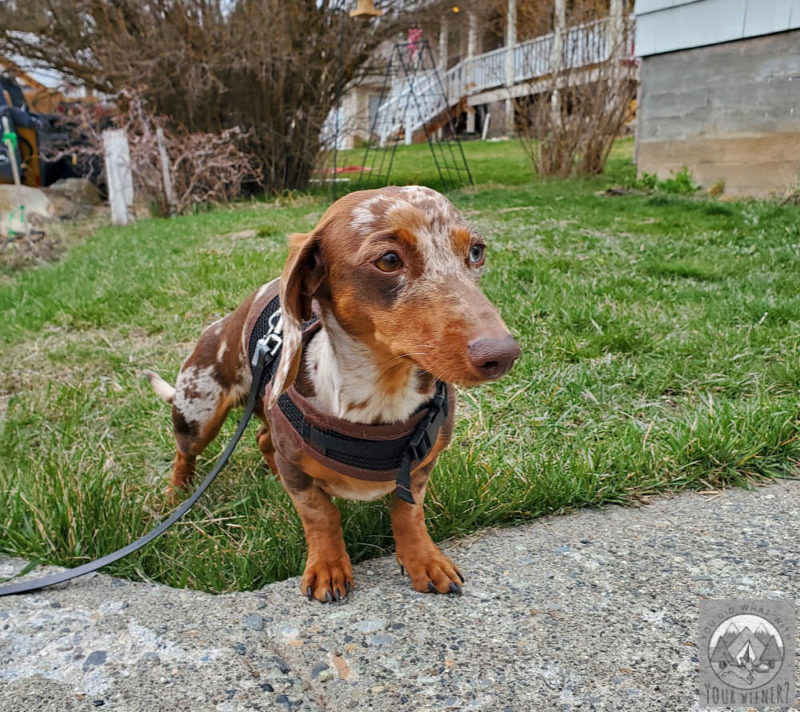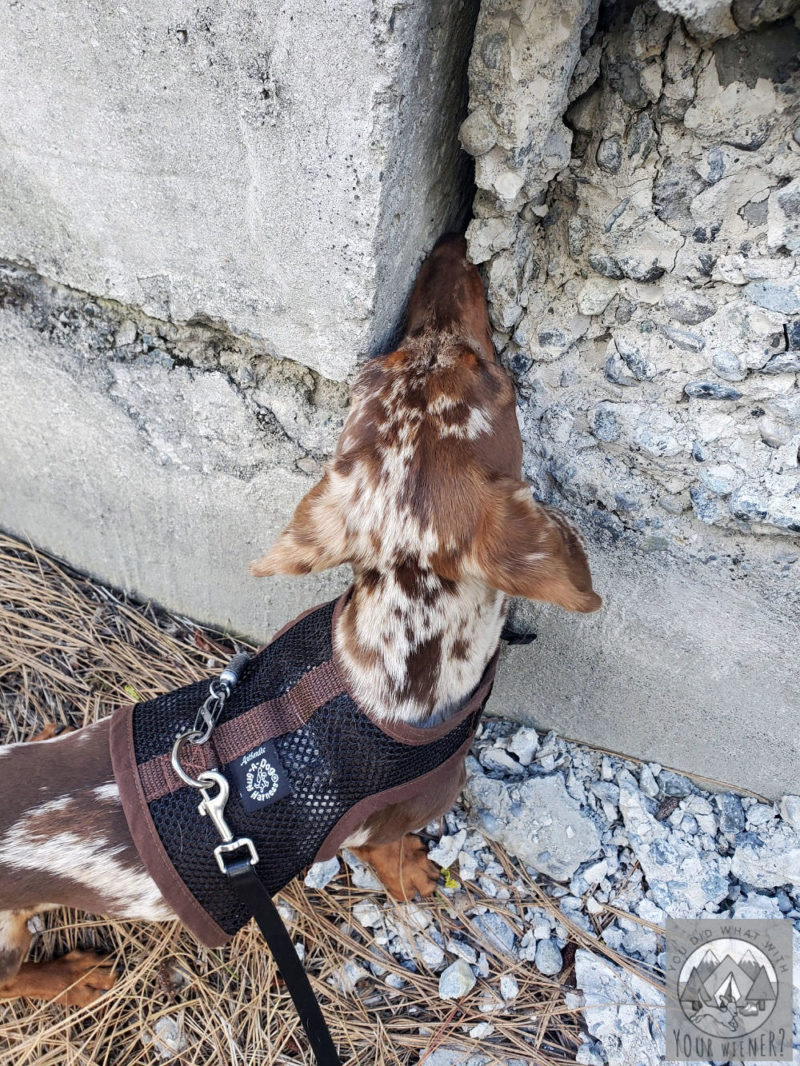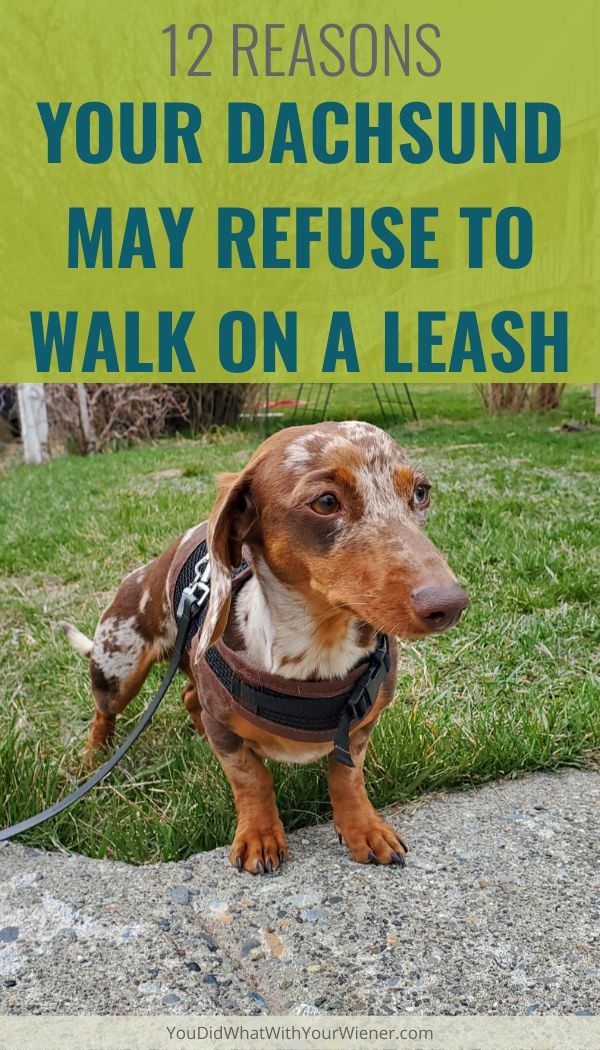12 Reasons Your Dachshund May Refuse to Walk on a Leash (and What to Do About It)
I hear it all the time: “What do I do when my Dachshund refuses to walk?”
It’s not uncommon for me to hear stories of people who tried to take their Dachshund out for a stroll and their dog dug in – pulling in the opposite direction on the leash – refusing to take another step forward.
I also hear a lot of stories from people who were happily walking along with their Dachshund and their dog suddenly stopped, laid down, and refused to get up.

One thing is common – everyone who shares their story with me is asking for help – so I thought I’d share what I know based on experience.
Why Would a Dachshund Refuse to Walk?
There are many reasons that a Dachshund may refuse to walk on a leash, but the first thing I tell people is that they need to try to figure out why.
In almost all cases, the reason is one of these 12 things.
1) Illness
While many Dachshunds just refuse to walk because they don’t like it for some reason, there is also a possibility that they could be not feeling well.
Your Dachshund may be temporarily not feeling good or there may be some underlying illness that is making them not feel well.
If you suspect this is a potential cause, and it doesn’t seem to resolve itself in a day or two, I suggest making an appointment with your vet to rule this out.
2) Undiagnosed pain
There may be something you can’t see on the outside, or something internal, that is causing your dog pain.
If you suspect this is the case, take your dog to see the veterinarian. They will know the most common test to run to rule out an injury.
3) Foot problems
Feet or paws could have a cut, be chafed on or between the pads, or be bruised by walking on a very rough surface like pointy rocks.
If you notice something wrong with your dog’s paw, seek medical attention if needed or take a break from walking until it heals.
4) Tender, raw skin
Legs or arm pits could be chafed due to current or previous rubbing of a harness or jacket.
Also, a dog could have allergies that can result in red, raw skin that gets further aggravated when walking.
If you notice mild chafing or red spots on your dog’s skin, don’t panic.
The problem will usually heal on its own with some rest or by using a different harness or jacket that doesn’t rub in the same spot.
If it is more severe, or doesn’t go away, it’s a good idea to visit your veterinarian to get it checked out.
5) Fear
Some dogs are just generally timid, especially young puppies going through a fear stage.
Some develop a fear after something scares them or they have what they perceive to be a bad experience.
Fear is also common with dogs who were not properly socialized when they were young.
If your Dachshund stops in their tracks on your walk, take note of your surroundings.
Pay attention to what your dog is focusing on or what they are trying to move away from (look in the opposite direction).
If you suspect fear, Socialization exercises can be done at, or around home, and may help your dog cope with new experiences better.
You may want to avoid encountering whatever it is for a while you work on desensitizing your Dachshund to it in in a non-scary, safe way.
6) Wearing something new
A new harness, jacket, or wearing one of these things when your Dachshund hasn’t before, can feel uncomfortable to them.
It may feel really weird or restrictive and make them reluctant to move.
If you think this is the cause, read my article on teaching your Dachshund to walk in a harness or jacket.
7) A new route
Dachshunds – and any dog really – can get used to a routine and get upset when things change.
If you ask your dog to walk on a different route or street than you normally do, they may protest.
The new street looks different, probably smells different, and may sound different.
Your Dachshund’s refusal to walk may be their way of saying, “This is not the right way” or “I’m unsure about this”.

This new, unfamiliar route may look scary, smell different, or your Dachshund simply may not understand that walking this direction is also ok.
Try taking the familiar route and try the new route again at a later time.
8) Asking a puppy to do too much too soon
Exercising a puppy can be tricky.
They have so much energy, but they are just learning to walk on a leash and the intensity and duration should be limited until their muscles and joints are fully developed.
If your Dachshund puppy suddenly puts the breaks on, or lays down, it’s likely their way of telling you that they’ve had enough for the day.
Also, puppies are new to the world so they don’t have a fitness base to start with.
It’s important for any dog to start with small periods of exercise and build up but slowly building fitness is especially important for a puppy.
9) Your senior dog is slowing down
I’ve been there – we think our dogs will live forever so we fail to adjust our expectations at the same rate of their physical ability declines.
Sometimes a senior dog’s physical stamina declines so slowly that we don’t notice at first.
Sometimes, they seem spry well past what we expect for their age and then suddenly “age years” overnight.
Other times, we think “well, I guess their walking days are over” because they are lagging behind on a walk, but they get a real pep in their step when you turn around to head for home and we feel fooled.
It can be hard to adjust our expectations when your 10 year old Dachshund used to happily go for 5-mile walks.
Since senior dogs often do better on a walk when their joints are warm, consider putting at least a light jacket on them unless it’s over 60 degrees.
You may also want to take a break from walking for a couple days, or cut the walks significantly shorter, so your dog has time to recover and see if that helps.
But, remember, a dog’s ability and desire for exercise declines with age, so be patient with them.
10) They’re tired
Just like people, dogs have good days and bad days.
Some days they are just tired. Maybe your dog just doesn’t feel like walking as far today.
It’s ok to change walking plans on occasion if your dog seems to just be having a bad day.
Just watch to make sure your Dachshund doesn’t think that you will give up every time they protest or they may start doing it more often.
It could also be that your Dachshund’s refusal to walk is not just being stubborn – it’s their way of communicating to you that they have had enough exercise today.
Make sure you know the signs your dog may be getting tired.
11) They don’t want the fun to end
Your Dachshund might be having a great time and they don’t want the fun to end.
They may protest if you ask them to leave or move on before they they’re ready.

Fun can include sniffing something really interesting, playing with a furry friend, or leaving a dog park.
You have two choices here: give in and let them enjoy a little bit more of what they want or take charge and insist that they leave with you, even if that means carrying your dog back to the house or car.
12) They have to go potty
Even thought this is last on the list, the #1 reason my Dachshunds refuse to walk is because they are looking for a spot to potty and I don’t realize it.
Some dogs need longer to sniff out the right spot to relieve themselves than others.
It can be difficult to tell the difference between the “I’m trying to find a place to pee” or “there is something stinky here I really want to check out” sniffing.
If your Dachshund starts to lean against the leash when you give it a little “let’s move on” tug, give them a few seconds more and see if they end up going potty.
If it’s apparent that your dog doesn’t have to go, then insist that the walk continue.
Once you can figure out why your Dachshund is refusing to walk on a leash, you can start to address the issue.
How to Get Your Dachshund Walking Again When They Stop and Refuse to Move
I’m not going to explain how to train your Dachshund to properly walk on leash (I summarized that in this article).
I assume you are reading this article because your Dachshund is willing to walk with you at least some of the time, but your issue is what to do when they stop suddenly and refuse to go on.
I listed reasons above that they might do this, and suggested what to do if you suspect one of those is the culprit.
But what if you’re ruled all of those out and there seems to be no cause? How can you get your Dachshund walking again?
First, you can try putting slight leash pressure (tension) on the leash in a gentle, steady fashion (no pulling hard or tugging).
Your dog will be “rewarded” by the release of pressure when they starts to move again.
Not all dog trainers will recommend this, but personally, knowing Dachshunds, I’m ok with using treats as a secondary reward for movement (luring ahead) in the beginning.
Start with a treat just far enough in front of their nose that they can smell it, but far enough away that they have to take a couple steps forward to eat it.
Gradually extend the distance they have to walk to be rewarded.
Note: You’ll want to start phasing them out as quickly as you can though so your dog doesn’t get dependent on them and refuse to walk unless one is present.
You can also try saying their name three or 4 times in a row in a rapid-paced, high-pitched tone to encourage your pup to get moving.
If either of these things work, you can start pairing a “movement” command like “let’s go” as soon as your dog moves your way at all.
If your pup still refuses to budge, pulling harder on the leash will likely result in them pulling even harder in the opposite direction, which can be dangerous if your Dachshund slips out of their harness.
Getting them to walk may come down to simply out-smarting them or trying a new trick.
Here are some suggestions to try:
- Switch directions and start walking in the opposite direction.
- Carry your dog to the end of the block and make them walk back to the house.
- Try a new setting altogether by driving to a different location.
- Walk your dog within the hour before meal-time (most Dachshunds get a little spunky before).
- Go walking with a friend and their dog, so yours feels the competition (like they have to keep up).
- Walk on dirt instead where the smells are more plentiful and interesting.
Remember that not all of these tricks will work for every dog and not all of them will work with the same dog every time.
The key to success is to keep trying different things to figure out what works for yours.
Final Thoughts
There are many reasons that a Dachshund may stop and refuse to walk.
The first step is trying to identify the cause, because it’s almost never just due to them being stubborn.
Once you figure that out, the solution may require a vet visit, require you to modify your expectations, may be temporary and may resolve on it’s own, or may need to be addressed with training.
I see many people say they have given up and stopped walking their Dachshund altogether because the experience is frustrating, but unfortunately, that can lead to behavior problems from lack of exercise, and obesity, and health issues.
My advice is don’t give up. Whatever the reason your Dachshund is resistant to walking, it likely isn’t as hard to fix as you think.
If you feel like you’ve tried everything in this article without success, consider consulting with an animal behaviorist or dog trainer.
They can observe your situation, give you some insight into the reason your dog is hesitant to walk, and give you some specific advice to address the problem.


About the Author
Hi, I’m Jessica. I’ve been studying the Dachshund breed since 2007, owned 3 of my own, and shared in the lives of thousands of others through their owner’s stories. When I’m not sharing what I know on this blog, you can find me hiking, camping, and traveling with my adventurous wiener dogs.

My 13 week old daschund just won’t walk maybe just a tiny bit. Will have to investigate all your knowledge in this article as to the reason
Hi I have a 12 week old miniature dashund we are having trouble getting him to walk outside . He simply sits at the door and refuses to move. I don’t want to drag him. I sometimes pick him up and take him sway from the house he will then walk a like but just cry’s. can you help!
Hi Alison. I totally understand this situation and that it may be frustrating. Your pup is very young so he may be shy and a bit scared of the outside world. First, I would work on his socialization (kind of a misnomer because a lot of it starts before he meets new dogs or people) and building his confidence. These two articles on my other Dachshund blog may help:
https://formydachshund.com/why-its-crucial-to-socialize-your-dachshund-and-how-to-do-it-right/
https://formydachshund.com/why-its-important-to-raise-a-confident-dachshund-and-how-to-do-it/
These tips will also help you get him used to walking on a leash. The article specifically addresses a harness or jacket but my tips would be similar for a young puppy. https://youdidwhatwithyourweiner.com/how-to-get-your-dachshund-to-walk-in-a-harness-or-jacket/
The clip on leashes falls just right to bang my dachshund in the wrists with each step. I turn her Easy Walk harness around backwards so the D ring is on her back. She still doesn’t pull and the clip doesn’t hit her anymore. If I want to use a D ring near her chest, like on a collar or the harness worn the right way, I loop a slip lead through the D ring and tie another leash to that if I want a longer lead. I taught her to heel on walks by giving her a kibble every few steps (she was earning a portion of her daily meals during training sessions). She also loves the Suddenly Settle game: I take a step/skip forward, back, or to the side and she gets a treat when she follows & sits.
Great work Genny. Thanks for the tips.
I recently adopted an 8 year old tweenie doxie, and since I had her groomed, she’s been super stubborn about walks. She’ll stop short and just plop down and not get up. We are still trying to get her over some nerves so she won’t go in the house so getting out is ESSENTIAL. Any advice?
Hi Melissa. Is it possible that she pulled something at the vet? While groomers try to be gentle, a lot of dogs will resist things like being put into a bathtub or having their arm held to cut the nails. If it’s not that, then it’s possible that the grooming experience itself gave her some anxiety so she’s hesitant to venture too far from the comfort of her house. If it’s not a medical reason, this article has some tips in it: https://youdidwhatwithyourweiner.com/how-to-get-your-dachshund-to-walk-in-a-harness-or-jacket/
We live in NYC and have a 6 th month old miniature long haired dachshund. Walks are very stressful , he pulls , barks and appears really scared. We have been working on changing direction , sitting to regroup, rewards when he moves forward with me without pulling . He still barks and the experience seems to be intensifying .
Hi Diane. It sounds like you are trying a lot of the right things. 6 months is the teenage stage for small dogs so it’s natural for them to develop some anxiety and become nervous/defensive in situations they weren’t before. I have some articles on my other Dachshund blog that might help. I will list them below here.
https://formydachshund.com/why-does-my-dachshund-bark-and-lunge-at-other-dogs-on-walks/
https://formydachshund.com/why-its-crucial-to-socialize-your-dachshund-and-how-to-do-it-right/
https://formydachshund.com/why-its-important-to-raise-a-confident-dachshund-and-how-to-do-it/
Good luck!
We’re having this same problem with our mini dachshund. She has become more and more resistant to walking around the neighborhood. I tried again yesterday and had to get behind her and prod her forward. I tried being patient. She just refused to go and pulled in the opposite direction. When I gave in and started heading back home, she had her nose to the ground going very fast, right up the walk and in the front door.
When she got in the house, she was jumping around, wagging her tail and made a bee line for the back door to be let out in the yard. I said fine, had my coat on and went out with her. She raced to the grass, found her ball then turned around to look right at me, wagging her tail. She loves the back yard. [g] But we walk and want to take her with us, but right now everyone has lost their patient having to struggle with her and then end up taking her home. Any suggestions?
btw, our dog is 1 year old now.
Hi Liz. This is a common Dachshund thing. They want what they want and will try to out-smart you or out stubborn you. You didn’t mention how old your Dachshund is but I assume she is not a very young puppy. I also assume, because you said she has become “more and more resistant” that this is a new behavior. First, by giving in and taking her home, it makes sense that she will become more resistant because she’s getting what she wants. I suggest you strengthen your resolve and stop giving in. Read through this article and see if there are some things you haven’t tried yet: https://youdidwhatwithyourweiner.com/how-to-get-your-dachshund-to-walk-in-a-harness-or-jacket/, The section at the bottom – 9 Ways to Out-Smart Your Dachshund into Walking – may be of particular help. Good luck.
I have a 1 weeks old wired haired miniature dachshund,wheni get is harness,and lead he gets really excited but as soon as I take him out he just crieds and refuses to walk,so how can I get my little man to lke going for walks.
Hi Susan. I assume that was a typo and you are not taking your 1 week old puppy outside for a walk. I assume your puppy is very young though. It may be that he is scared outside. Here are two articles that may help: https://youdidwhatwithyourweiner.com/how-to-get-your-dachshund-to-walk-in-a-harness-or-jacket/ and https://youdidwhatwithyourweiner.com/how-to-raise-a-calm-friendly-dachshund/. Good luck.
We just adopted a 9-year-old dachshund mix. I took her on her first walk today and she did very well, until she didn’t lol. We were heading back to the car when something perked her interest but she wanted to investigate too far off the path and into a muddy area, and I didn’t want mud in my car. I tugged and guided her back to the path where she promptly sat down and wouldn’t budge! I finally just picked her up (being a dachshund mix, she’s kinda heavy) and carried her a few feet. Put her back down and she started walking nicely again. After we got back home I started googling walking the breed and seems this is a trait. Sounds like I did the right thing in this situation. I’m just glad I didn’t have to carry her all the way back to my car lol.
You did! Glad it worked. I’m glad you didn’t have to carry her all of the way either. Even mine, which are 10 lbs each, get really heavy in my arms after a quarter mile.